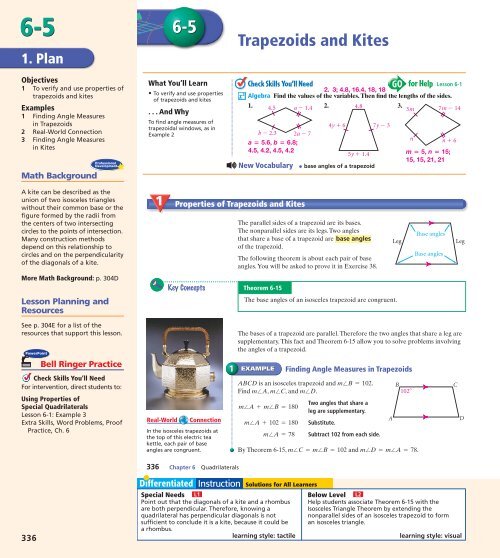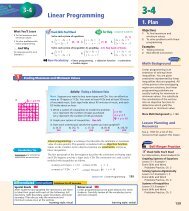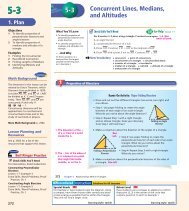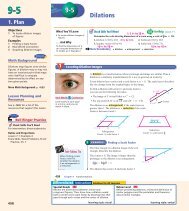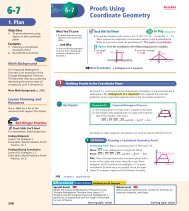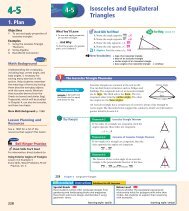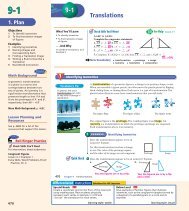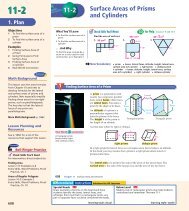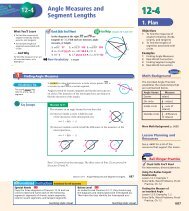6-5 Trapezoids and Kites
6-5 Trapezoids and Kites
6-5 Trapezoids and Kites
You also want an ePaper? Increase the reach of your titles
YUMPU automatically turns print PDFs into web optimized ePapers that Google loves.
6-5<br />
1. Plan<br />
Objectives<br />
1 To verify <strong>and</strong> use properties of<br />
trapezoids <strong>and</strong> kites<br />
Examples<br />
1 Finding Angle Measures<br />
in <strong>Trapezoids</strong><br />
2 Real-World Connection<br />
3 Finding Angle Measures<br />
in <strong>Kites</strong><br />
Math Background<br />
A kite can be described as the<br />
union of two isosceles triangles<br />
without their common base or the<br />
figure formed by the radii from<br />
the centers of two intersecting<br />
circles to the points of intersection.<br />
Many construction methods<br />
depend on this relationship to<br />
circles <strong>and</strong> on the perpendicularity<br />
of the diagonals of a kite.<br />
More Math Background: p. 304D<br />
Lesson Planning <strong>and</strong><br />
Resources<br />
See p. 304E for a list of the<br />
resources that support this lesson.<br />
PowerPoint<br />
336<br />
Bell Ringer Practice<br />
Check Skills You’ll Need<br />
For intervention, direct students to:<br />
Using Properties of<br />
Special Quadrilaterals<br />
Lesson 6-1: Example 3<br />
Extra Skills, Word Problems, Proof<br />
Practice, Ch. 6<br />
6-5<br />
What You’ll Learn<br />
• To verify <strong>and</strong> use properties<br />
of trapezoids <strong>and</strong> kites<br />
. . . And Why<br />
To find angle measures of<br />
trapezoidal windows, as in<br />
Example 2<br />
1<br />
336 Chapter 6 Quadrilaterals<br />
<strong>Trapezoids</strong> <strong>and</strong> <strong>Kites</strong><br />
x2 x 2<br />
Lesson 6-1<br />
2. 3; 4.8, 16.4, 18, 18<br />
Algebra Find the values of the variables. Then find the lengths of the sides.<br />
1. 4.5 a - 1.4 2. 4.8<br />
3.<br />
3m 7m - 14<br />
b - 2.3 2a - 7<br />
a ≠ 5.6, b ≠ 6.8;<br />
4.5, 4.2, 4.5, 4.2<br />
1 Properties of <strong>Trapezoids</strong> <strong>and</strong> <strong>Kites</strong><br />
Real-World<br />
Key Concepts Theorem 6-15<br />
Connection<br />
In the isosceles trapezoids at<br />
the top of this electric tea<br />
kettle, each pair of base<br />
angles are congruent.<br />
Check Skills You’ll Need GO for Help<br />
New Vocabulary • base angles of a trapezoid<br />
The parallel sides of a trapezoid are its bases.<br />
The nonparallel sides are its legs. Two angles<br />
that share a base of a trapezoid are base angles<br />
of the trapezoid.<br />
The following theorem is about each pair of base<br />
angles. You will be asked to prove it in Exercise 38.<br />
The base angles of an isosceles trapezoid are congruent.<br />
n<br />
n + 6<br />
The bases of a trapezoid are parallel. Therefore the two angles that share a leg are<br />
supplementary. This fact <strong>and</strong> Theorem 6-15 allow you to solve problems involving<br />
the angles of a trapezoid.<br />
EXAMPLE<br />
Finding Angle Measures in <strong>Trapezoids</strong><br />
ABCD is an isosceles trapezoid <strong>and</strong> m&B = 102.<br />
Find m&A, m&C, <strong>and</strong> m&D.<br />
m&A + m&B = 180<br />
m&A + 102 = 180 Substitute.<br />
4y + 6<br />
5y + 1.4<br />
Two angles that share a<br />
leg are supplementary.<br />
m&A = 78 Subtract 102 from each side.<br />
7y - 3<br />
By Theorem 6-15, m&C = m&B = 102 <strong>and</strong> m&D = m&A = 78.<br />
m ≠ 5, n ≠ 15;<br />
15, 15, 21, 21<br />
Base angles<br />
Leg Leg<br />
Base angles<br />
B C<br />
102<br />
A D<br />
Special Needs L1<br />
Below Level L2<br />
Point out that the diagonals of a kite <strong>and</strong> a rhombus Help students associate Theorem 6-15 with the<br />
are both perpendicular. Therefore, knowing a<br />
Isosceles Triangle Theorem by extending the<br />
quadrilateral has perpendicular diagonals is not<br />
nonparallel sides of an isosceles trapezoid to form<br />
sufficient to conclude it is a kite, because it could be<br />
a rhombus.<br />
an isosceles triangle.<br />
learning style: tactile learning style: visual
Quick Check<br />
You are looking up at<br />
Harbour Centre Tower in<br />
Vancouver, Canada.<br />
Quick Check<br />
Key Concepts Theorem 6-16<br />
Proof<br />
1 In the isosceles trapezoid, m&S = 70.<br />
Find m&P, m&Q, <strong>and</strong> m&R.<br />
110, 110, 70<br />
2<br />
EXAMPLE Real-World Connection<br />
Architecture The second ring of the ceiling shown at the left is made from<br />
congruent isosceles trapezoids that create the illusion of circles. What are the<br />
measures of the base angles of these trapezoids?<br />
Each trapezoid is part of an isosceles triangle whose base angles are the acute base<br />
angles of the trapezoid. The isosceles triangle has a vertex angle that is half as large<br />
as one of the 20 angles at the center of the ceiling.<br />
The measure of each angle at the center of the ceiling is<br />
360<br />
20<br />
or 18.<br />
The measure of &1 is<br />
18<br />
2<br />
, or 9.<br />
The measure of each acute base angle is<br />
180 2 9<br />
2<br />
, or 85.5.<br />
The measure of each obtuse base angle is 180 - 85.5, or 94.5.<br />
2 A glass ceiling like the one above has 18 angles meeting at the center instead of 20.<br />
What are the measures of the base angles of the trapezoids in its second ring? 85, 95<br />
Like the diagonals of parallelograms, the diagonals of an isosceles trapezoid have a<br />
special property.<br />
Proof of Theorem 6-16<br />
Advanced Learners L4<br />
After students read the proof of Theorem 6-16, have<br />
them write a paragraph explaining whether the<br />
diagonals of an isosceles trapezoid bisect each other.<br />
1<br />
The diagonals of an isosceles trapezoid are congruent.<br />
P Q<br />
70<br />
S R<br />
Given: Isosceles trapezoid ABCD with AB > DC<br />
A D<br />
Prove: AC > DB<br />
It is given that AB > DC.<br />
Because the base<br />
angles of an isosceles trapezoid are congruent,<br />
B C<br />
&ABC > &DCB. By the Reflexive Property of Congruence, BC > BC.Then,<br />
by the SAS Postulate, #ABC > #DCB.Therefore, AC > DB by CPCTC.<br />
Another special quadrilateral that is not a parallelogram is a kite. The diagonals of<br />
a kite, like the diagonals of a rhombus, are perpendicular. A proof of this for a kite<br />
(next page) is quite like its proof for a rhombus (at the top of page 330).<br />
learning style: verbal<br />
Lesson 6-5 <strong>Trapezoids</strong> <strong>and</strong> <strong>Kites</strong> 337<br />
English Language Learners ELL<br />
Draw several trapezoids in different orientations <strong>and</strong><br />
have students identify the bases, legs <strong>and</strong> base angles.<br />
Emphasize that the parallel sides are called bases <strong>and</strong><br />
are independent of their orientation.<br />
learning style: verbal<br />
2. Teach<br />
Guided Instruction<br />
1<br />
Error Prevention<br />
Some students may think the base<br />
angles of an isosceles trapezoid<br />
have vertices only on the “bottom”<br />
side. This misconception stems from<br />
the common use of the word base<br />
to mean “the side of a figure on<br />
which it rests.” Point out that each<br />
isosceles trapezoid has two bases,<br />
which may lie in any orientation,<br />
<strong>and</strong> two pairs of base angles.<br />
2<br />
EXAMPLE<br />
EXAMPLE<br />
Careers<br />
Architects design modern office<br />
buildings using not only<br />
trapezoids <strong>and</strong> squares but also<br />
triangles, circles, <strong>and</strong> ellipses.<br />
Connection to Engineering<br />
Have students find how a<br />
keystone is used <strong>and</strong> how its<br />
shape relates to this lesson.<br />
Visual Learners<br />
When proving that the diagonals<br />
of an isosceles trapezoid are<br />
congruent, have students<br />
separately draw <strong>and</strong> label the<br />
overlapping triangles ABC <strong>and</strong><br />
DCB to help them see how the<br />
parts correspond <strong>and</strong> why the<br />
triangles are congruent.<br />
PowerPoint<br />
Additional Examples<br />
1 XYZW is an isosceles trapezoid,<br />
<strong>and</strong> m&X = 156. Find m&Y, m&Z,<br />
<strong>and</strong> m&W.<br />
X Y<br />
156°<br />
W<br />
mlY ≠ 156,<br />
mlZ ≠ mlW ≠ 24<br />
2 Half of a spider’s web is<br />
shown below, formed by layers<br />
of congruent isosceles trapezoids.<br />
Find the measures of the angles<br />
in ABDC.<br />
A<br />
B<br />
C<br />
D<br />
mlA ≠ mlB ≠ 75,<br />
mlC ≠ mlD ≠ 105<br />
Z<br />
337
Math Tip<br />
After students read the proof<br />
of Theorem 6-17, ask: Are both<br />
diagonals bisected? No; the figure<br />
then would be a parallelogram.<br />
3<br />
338<br />
EXAMPLE<br />
Teaching Tip<br />
Discuss as a class how to prove<br />
DBA DBC using SSS.<br />
PowerPoint<br />
Additional Examples<br />
3 Find m&1, m&2, <strong>and</strong> m&3<br />
in the kite.<br />
S<br />
R<br />
U<br />
ml1 ≠ 72, ml2 ≠ 90,<br />
ml3 ≠ 18<br />
Resources<br />
• Daily Notetaking Guide 6-5 L3<br />
• Daily Notetaking Guide 6-5—<br />
Adapted Instruction L1<br />
Closure<br />
Draw <strong>and</strong> label an isosceles<br />
trapezoid, a (convex) kite, <strong>and</strong><br />
their diagonals. Then write<br />
congruence statements for all<br />
pairs of triangles that you can<br />
prove congruent. Students<br />
should find three pairs of<br />
congruent triangles for each<br />
figure.<br />
1<br />
D<br />
3 2<br />
72°<br />
T<br />
Proof<br />
Quick Check<br />
Example 1<br />
(page 336)<br />
3<br />
Proof of Theorem 6-17<br />
Given: Kite RSTW with TS > TW<strong>and</strong><br />
RS > RW<br />
Prove: TR ' SW<br />
Both T <strong>and</strong> R are equidistant from S <strong>and</strong> W. By the Converse<br />
of the Perpendicular Bisector Theorem, T <strong>and</strong> R lie on the<br />
perpendicular bisector of SW. Since there is exactly one line<br />
through any two points (Postulate 1-1), TR must be the<br />
perpendicular bisector of SW.<br />
Therefore, TR ' SW.<br />
You can use Theorem 6-17 to find angle measures in kites.<br />
EXAMPLE<br />
Finding Angle Measures in <strong>Kites</strong><br />
Find m&1, m&2, <strong>and</strong> m&3 in the kite.<br />
m&1 = 90 Diagonals of a kite are perpendicular.<br />
90 + m&2 + 32 = 180 Triangle Angle-Sum Theorem<br />
122 + m&2 = 180 Simplify.<br />
m&2 = 58 Subtract 122 from each side.<br />
#ABD > #CBD by SSS.<br />
By CPCTC, m&3 = m&DBC = 32.<br />
3 Find m&1, m&2, <strong>and</strong> m&3 in the kite.<br />
90, 46, 44<br />
EXERCISES<br />
For more exercises, see Extra Skill, Word Problem, <strong>and</strong> Proof Practice.<br />
Practice <strong>and</strong> Problem Solving<br />
A<br />
Key Concepts Theorem 6-17<br />
Practice by Example<br />
GO for<br />
Help<br />
338 Chapter 6 Quadrilaterals<br />
The diagonals of a kite are perpendicular.<br />
Each trapezoid is isosceles. Find the measure of each angle.<br />
1.<br />
3 2<br />
2.<br />
111<br />
1<br />
69, 69,<br />
111<br />
3.<br />
2 3<br />
77<br />
77, 103, 103<br />
1<br />
3<br />
2<br />
1<br />
49<br />
49, 131, 131<br />
4. Z 5. Q R 6. B C<br />
Y<br />
105,<br />
105<br />
X<br />
75, 75<br />
65<br />
P<br />
115, 115, 65<br />
S<br />
A<br />
60<br />
120, 120, 60<br />
D<br />
W<br />
46<br />
2<br />
17. Answers may vary. Sample:<br />
3<br />
1<br />
S<br />
A<br />
Z<br />
3<br />
T<br />
R<br />
B<br />
D<br />
32<br />
1 2<br />
C<br />
W
Example 2<br />
(page 337)<br />
7a. isosc. trapezoids<br />
Example 3<br />
(page 338)<br />
13. 90, 55, 90, 55, 35<br />
14. 90, 52, 38, 37, 53<br />
15. 90, 90, 90, 90, 46, 34,<br />
56, 44, 56, 44<br />
16. 112, 112<br />
GO<br />
B<br />
Apply Your Skills<br />
nline<br />
Homework Help<br />
Visit: PHSchool.com<br />
Web Code: aue-0605<br />
x2 x 2<br />
19. Explanations may vary.<br />
Sample: If both ' are<br />
bisected, then this<br />
combined with KM O<br />
KM by the Reflexive<br />
Prop. means kKLM O<br />
kKNM by SAS. By<br />
7. Design Each patio umbrella is made<br />
of eight panels that are congruent<br />
isosceles triangles with parallel<br />
stripes. A sample panel is shown<br />
at the right. The vertex angle<br />
of the panel measures 42.<br />
a. Classify the quadrilaterals<br />
shown as blue stripes on<br />
the panel.<br />
b. Find the measures of<br />
the quadrilaterals’<br />
interior angles.<br />
69, 69, 111, 111<br />
Find the measures of the numbered angles in each kite.<br />
8. 22<br />
9. 45 10.<br />
1 90, 68 3 90, 45,<br />
2<br />
1 2 45<br />
11. 12. 90, 40, 13.<br />
64<br />
1<br />
3<br />
2<br />
50 13<br />
90<br />
90, 26, 90<br />
14.<br />
2 4<br />
15.<br />
9<br />
10<br />
16.<br />
38<br />
3<br />
1 53<br />
5<br />
34<br />
6<br />
1 2<br />
34<br />
46<br />
5<br />
17. Open-Ended Sketch two kites that are not congruent, but with the diagonals of<br />
one congruent to the diagonals of the other. See margin.<br />
18. The perimeter of a kite is 66 cm. The length of one of its sides is 3 cm less than<br />
twice the length of another. Find the length of each side of the kite.<br />
12, 12, 21, 21<br />
19. Critical Thinking If KLMN is an isosceles trapezoid, is it possible for KM to<br />
bisect &LMN <strong>and</strong> &LKN? Explain. See margin.<br />
Algebra Find the value of the variable in each isosceles trapezoid.<br />
20.<br />
12<br />
T W 21.<br />
15<br />
M N 22. B<br />
15 60<br />
C<br />
(3x + 15)<br />
60 5x<br />
S R<br />
2<br />
45 3x<br />
L O<br />
A D<br />
23.<br />
3<br />
T U 24.<br />
4<br />
R S 25.<br />
1<br />
Q R<br />
U<br />
T<br />
S V<br />
TV = 2x - 1<br />
US = x + 2<br />
SU = x + 1<br />
TR = 2x - 3<br />
P<br />
QS = x + 5<br />
RP = 3x + 3<br />
S<br />
78<br />
CPCTC, opp. &L O &N.<br />
&L <strong>and</strong> &N are opp., but<br />
KLMN is isos., both<br />
pairs of base &’s are<br />
also O. By the Trans.<br />
Prop., all 4 angles are O,<br />
so KLMN must be a rect.<br />
108, 108<br />
1<br />
54 90<br />
2<br />
1<br />
35<br />
5<br />
2<br />
2<br />
1<br />
3<br />
4<br />
468<br />
Lesson 6-5 <strong>Trapezoids</strong> <strong>and</strong> <strong>Kites</strong> 339<br />
or a square. This<br />
contradicts what is gien,<br />
so KM cannot bisect<br />
&LMN <strong>and</strong> &LKN.<br />
3. Practice<br />
Assignment Guide<br />
1<br />
A B 1-39<br />
C Challenge 40-44<br />
Test Prep 45-50<br />
Mixed Review 51-56<br />
Homework Quick Check<br />
To check students’ underst<strong>and</strong>ing<br />
of key skills <strong>and</strong> concepts, go over<br />
Exercises 6, 14, 29, 37, 38.<br />
Diversity<br />
Exercise 7 The word umbrella<br />
comes from a Latin word meaning<br />
“shaded area or shadow,”<br />
suggesting protection against the<br />
rain or sun. Ask whether students<br />
know the word for umbrella in<br />
other languages. For example,<br />
the Spanish word paraguas<br />
literally means “for water,”<br />
<strong>and</strong> a sombrilla is a parasol.<br />
Exercise 10 Discuss ways to prove<br />
m&1 = m&2.<br />
Exercise 38 Have students work<br />
together to write this proof.<br />
Even with the Plan, the proof<br />
is complex <strong>and</strong> worthy of class<br />
discussion.<br />
GPS<br />
Enrichment<br />
Guided Problem Solving<br />
Reteaching<br />
Adapted Practice<br />
Name Class Date<br />
Practice 6-5<br />
Find the measures of the numbered angles in each isosceles trapezoid.<br />
1. 2<br />
2.<br />
99<br />
3.<br />
4. 5. 2<br />
6.<br />
2<br />
96<br />
Algebra Find the value(s) of the variable(s) in each isosceles trapezoid.<br />
7. 3x 3<br />
8. (6x 20)<br />
9. L M<br />
x 1<br />
Find the measures of the numbered angles in each kite.<br />
10. 11. 12.<br />
101<br />
1 2<br />
2<br />
1 65<br />
48<br />
13. 14. 15.<br />
59<br />
2<br />
1 27<br />
3<br />
62<br />
x 5<br />
Algebra Find the value(s) of the variable(s) in each kite.<br />
<strong>Trapezoids</strong> <strong>and</strong> <strong>Kites</strong><br />
16. 17. (5x 1)<br />
18. (y 9) (4x 13)<br />
© Pearson Education, Inc. All rights reserved. Practice<br />
1<br />
1<br />
(2x)°<br />
(10x 6)<br />
(3x)<br />
1<br />
1<br />
(4x)<br />
1 2<br />
87<br />
(8x)<br />
2<br />
79<br />
y<br />
2<br />
121<br />
1<br />
1<br />
G O 3 CS 060<br />
7x<br />
O N<br />
2<br />
67<br />
2y 5<br />
1<br />
44 80<br />
2<br />
(5x 15)<br />
51<br />
1 3<br />
2<br />
L4<br />
L1<br />
y<br />
L3<br />
L2<br />
L3<br />
339
4. Assess & Reteach<br />
PowerPoint<br />
34. No; if two consecutive '<br />
are suppl., then another<br />
pair must be also<br />
because one pair of opp.<br />
' is O. Therefore, the<br />
opp. ' would be O,<br />
which means the figure<br />
would be a ~ <strong>and</strong> not a<br />
kite.<br />
340<br />
Lesson Quiz<br />
Use isosceles trapezoid ABCD for<br />
Exercises 1 <strong>and</strong> 2.<br />
A B<br />
D C<br />
1. If m&A = 45, find<br />
m&B, m&C, <strong>and</strong> m&D. mlB<br />
≠ 45,<br />
mlC ≠ mlD ≠ 135<br />
2. If AC = 3x - 16 <strong>and</strong><br />
BD = 10x - 86, find x. 10<br />
Use kite GHIJ for Exercises 3–6.<br />
H<br />
G<br />
3<br />
4<br />
1<br />
50°<br />
I<br />
9°<br />
2<br />
3. Find m&1. 90<br />
4. Find m&2. 9<br />
5. Find m&3. 81<br />
6. Find m&4. 40<br />
Alternative Assessment<br />
Have students work in pairs to<br />
write answers to the following<br />
questions:<br />
• How are a kite <strong>and</strong> a rhombus<br />
similar? How are they<br />
different?<br />
• How are an isosceles trapezoid<br />
<strong>and</strong> a rectangle similar? How<br />
are they different?<br />
J<br />
Exercises 29–30<br />
112<br />
31. Yes, the O ' can be<br />
obtuse.<br />
32. Yes, the O ' can be<br />
obtuse, as well as<br />
one other l.<br />
33. Yes; if 2 O ' are rt. ',<br />
they are suppl. The<br />
other 2 ' are also<br />
suppl.<br />
43. D is any point on BN<br />
such that ND u BN <strong>and</strong><br />
D is below N.<br />
4<br />
C<br />
Challenge<br />
41. It is one half the sum<br />
of the lengths of the<br />
bases; draw a diag.<br />
of the trap. to form<br />
2 >. The bases B<br />
<strong>and</strong> b of the trap. are<br />
each a base of a n.<br />
Then the segment<br />
joining the midpts.<br />
of the non-n sides is<br />
the sum of the<br />
midsegments of the<br />
>. This sum is<br />
1 1 1<br />
2B<br />
± 2b<br />
≠ 2(B<br />
± b).<br />
340 Chapter 6 Quadrilaterals<br />
35. Yes; the O ' must be<br />
45° or 135° each.<br />
36. No; if two consecutive '<br />
were compl., then the<br />
kite would be concave.<br />
37. Rhombuses <strong>and</strong> squares<br />
would be kites since opp.<br />
sides can be O also.<br />
x Algebra Find the value(s) of the variable(s) in each kite.<br />
26. 27. (3x 5)<br />
28.<br />
y<br />
y<br />
6x<br />
(x 6)<br />
(2y 20)<br />
2x<br />
(2x 4)<br />
(4x 30)<br />
3x<br />
2<br />
2 x 2<br />
28<br />
x ≠ 35, y ≠ 30 x ≠ 18, y ≠ 108<br />
Bridge Design A quadrilateral is formed by the beams of the bridge at the left.<br />
Isosc. trapezoid; all the<br />
29. Classify the quadrilateral. Explain your reasoning. large rt. > appear to be O.<br />
30. Find the measures of the other interior angles of the quadrilateral.<br />
112, 68, 68<br />
Critical Thinking Can two angles of a kite be as follows? Explain.<br />
31–33. See below left.<br />
31. opposite <strong>and</strong> acute 32. consecutive <strong>and</strong> obtuse<br />
33. opposite <strong>and</strong> supplementary 34. consecutive <strong>and</strong> supplementary<br />
35. opposite <strong>and</strong> complementary 36. consecutive <strong>and</strong> complementary<br />
34–36. See margin.<br />
37. Writing A kite is sometimes defined as a quadrilateral with two pairs of<br />
consecutive sides congruent. Compare this to the definition you learned in<br />
Lesson 6-1. Are parallelograms, trapezoids, rhombuses, rectangles, or squares<br />
special kinds of kites according to the changed definition? Explain. See margin.<br />
38. Developing Proof The plan suggests a proof of Theorem 6-15. Write a proof<br />
GPS that follows the plan. See back of book.<br />
Given: Isosceles trapezoid ABCD with AB > DC<br />
A D<br />
Prove: &B > &C <strong>and</strong> &BAD > &D<br />
1<br />
B<br />
C<br />
E<br />
Plan: Begin by drawing AE 6 DC to form<br />
parallelogram AECD so that AE > DC > AB.<br />
&B > &C because &B > &1 <strong>and</strong> &1 > &C. Also, &BAD > &D<br />
because they are supplements of the congruent angles, &B <strong>and</strong> &C.<br />
Proof Write a proof. Use the given figure with additional lines as needed.<br />
39. Given: Isosceles trapezoid TRAP with TR > PA<br />
Prove: &RTA > &APR See margin.<br />
T P<br />
40. Given: Isosceles trapezoid TRAP with TR > PA;<br />
BI is the perpendicular bisector of RA intersecting<br />
RA at B <strong>and</strong> TP at I. See margin.<br />
Prove: BI is the perpendicular bisector of TP.<br />
R A<br />
For a trapezoid, consider the segment joining the midpoints of the two given<br />
segments. How are its length <strong>and</strong> the lengths of the two parallel sides of the<br />
trapezoid related? Justify your answer.<br />
41. the two nonparallel sides 42. the diagonals<br />
See left.<br />
See margin.<br />
* )<br />
43. BN is the perpendicular bisector of AC at N.<br />
B<br />
Describe the set of points, D, for which ABCD is a kite.<br />
See above left.<br />
Proof 44. Prove that the angles formed by the noncongruent sides<br />
of a kite are congruent. (Hint: Draw a diagonal of the kite.)<br />
See back of book.<br />
A N<br />
39. Answers may vary.<br />
Sample: Draw TA <strong>and</strong> RP.<br />
1. isosc. trapezoid TRAP<br />
(Given)<br />
2. TA O PR (Diagonals<br />
of an isosc. trap. are O.)<br />
3. TR O PA (Given)<br />
4. RA O RA (Refl. Prop.<br />
of O)<br />
5. kTRA OkPAR (SSS)<br />
6. lRTA OlAPR<br />
(CPCTC)<br />
C
Test Prep<br />
Multiple Choice<br />
Short Response<br />
49. [2] a. (2x – 8) ± (x – 4)<br />
≠ x ± 2 OR<br />
equivalent<br />
equation; x ≠ 7<br />
b. 9, 9<br />
[1] one computational<br />
error<br />
Mixed Review<br />
GO for<br />
Help<br />
Lesson 6-4<br />
Lesson 5-2<br />
Lesson 4-2<br />
x2 x 2<br />
lesson quiz, PHSchool.com, Web Code: aua-0605<br />
40. Draw BI as described,<br />
then draw BT <strong>and</strong> BP.<br />
1. TR O PA (Given)<br />
2. lR OlA (Base ' of<br />
isosc. trap. are O.)<br />
3. RB O AB (Def. of<br />
bisector)<br />
45. Which statement is true for every trapezoid? B<br />
A. Exactly two sides are congruent. B. Exactly two sides are parallel.<br />
C. Opposite angles are supplementary. D. The diagonals bisect each other.<br />
46. Which statement is true for every kite? J<br />
F. Opposite sides are congruent. G. At least two sides are parallel.<br />
H. Opposite angles are supplementary. J. The diagonals are perpendicular.<br />
47. Two consecutive angles of a trapezoid are right angles. Three of the<br />
following statements about the trapezoid could be true. Which statement<br />
CANNOT be true? A<br />
A. The two right angles are base angles.<br />
B. The diagonals are not congruent.<br />
C. Two of the sides are congruent.<br />
D. No two sides are congruent.<br />
48. Quadrilateral EFGH is a kite. What is the<br />
value of x? H<br />
F. 15<br />
G. 70<br />
H. 85<br />
J. 160<br />
49. In the trapezoid at the right, BE 5 2x 2 8,<br />
DE 5 x 2 4,<br />
<strong>and</strong> AC 5 x 1 2.<br />
a. Write <strong>and</strong> solve an equation for x.<br />
b. Find the length of each diagonal.<br />
50. Diagonal RB of kite RHBW forms an equilateral triangle with two of the<br />
sides. m&BWR = 40. Draw <strong>and</strong> label a diagram showing the diagonal <strong>and</strong><br />
the measures of all the angles. Which angles of the kite are largest?<br />
See margin.<br />
Find the indicated angle measures for the rhombus.<br />
51. m&1 126 52. m&2 27 53. m&3<br />
Algebra Find the values indicated.<br />
54. a. a<br />
b. FG<br />
F<br />
2a - 3<br />
55. a. x<br />
b. CD<br />
c. GH E<br />
G<br />
c. BC<br />
a. 4<br />
b. 5<br />
c. 5<br />
a + 1<br />
H<br />
a. 3<br />
b. 30<br />
c. 30<br />
56. State the postulate that justifies the<br />
statement #ABC > #DEF. SAS<br />
4. kTRB OkPAB (SAS)<br />
5. BT O BP (CPCTC)<br />
6. lRBT OlABP<br />
(CPCTC)<br />
7. lTBI OkPBI (Compl.<br />
of O'are O.)<br />
8. BI O BI (Refl. Prop.<br />
of O)<br />
A<br />
G<br />
F<br />
75<br />
H<br />
x<br />
E<br />
20<br />
A D<br />
B<br />
E<br />
C<br />
27<br />
B C D<br />
F E<br />
A<br />
D B<br />
2x + 24 7x + 9<br />
C<br />
Lesson 6-5 <strong>Trapezoids</strong> <strong>and</strong> <strong>Kites</strong> 341<br />
2<br />
126<br />
9. kTBI OkPBI (SAS)<br />
10. lBIT OlBIP (CPCTC)<br />
11. lBIT <strong>and</strong> lBIP are<br />
rt. '. (O supp. ' are<br />
rt. '.)<br />
12. TI O PI (CPCTC)<br />
13. BI is # bis. of TP.<br />
(Def. of # bis.)<br />
1<br />
3<br />
Test Prep<br />
Resources<br />
For additional practice with a<br />
variety of test item formats:<br />
• St<strong>and</strong>ardized Test Prep, p. 361<br />
• Test-Taking Strategies, p. 356<br />
• Test-Taking Strategies with<br />
Transparencies<br />
42. It is one half the<br />
difference of the lengths<br />
of the bases; from<br />
Ex. 41, the length of the<br />
segment joining the<br />
midpts. of the non- n<br />
1<br />
sides is 2(B<br />
± b). By the<br />
Side-Splitter Thm., the<br />
middle part of this<br />
segment joins the<br />
midpts. of the diags.<br />
Each outer segment<br />
1<br />
measures 2 b. So the<br />
length of the segment<br />
connecting the midpts.<br />
of the diags. is<br />
1<br />
2(B<br />
– b).<br />
50. [2]<br />
R<br />
60° 70°<br />
H 60° 40° W<br />
60° 70°<br />
B<br />
lHRW <strong>and</strong> lHBW<br />
[1] incorrect diagram<br />
OR no work shown<br />
341


